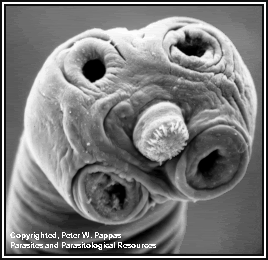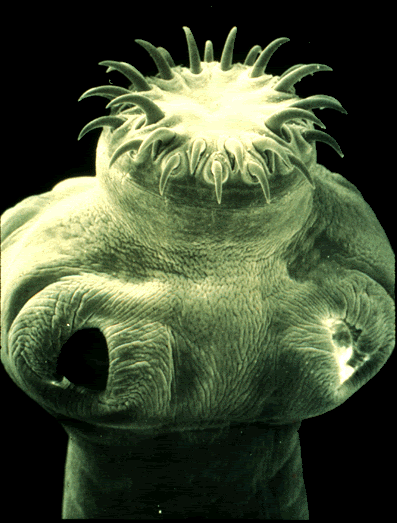And remember kids - well done is good for you ^_^
First post FTW (or FTF)
Today we'll be talking about tapeworms, beef tapeworms, pork tapeworms and the wonderful structures that keep them firmly lodged into the inside of your guts, like this little bugger:

Tape worms are endoparasitic flatworms ( a.k.a Cestordes) specializing in multi-host life circles which include much shape-shifting, a lot of self-copying and finally an adult in large vertebrates, such as us, which reproduce with itself to make a thousands of the likes of it.
In Intestinal Cestodes describe the gut-dwelling worm as a segmented, band like in its adult stage. What occurs in tissues and organs of vertebrates or humans, is the growth of a cyst-like juvenile or metacestode stage. The potential cause of illnesses and diseases is due to the metacestode stages happening in human tissues rather than the adult tapeworm.
The tegument is the body surface of the adult tapeworm and due to this the tapeworms take the host nutrients and not attack the mucosa of the small intestine, or remove blood, hence infections are instead benevolent and most often don't show any signs of illness. A carrier can notice the segments (proglottides) when using the bathroom for instance in the feces in a toilet bowl, around a latrine or frequently because the tapeworms are moving around constantly one may find it in the under-garments.
Here's how it happens in two nice doodles:


The Scolex or "head" of the worm attaches to the intestine of the definitive host. In some groups, the scolex is dominated by bothria, which are sometimes called "sucking grooves", and function like suction cups. Other groups have hooks and suckers that aid in attachment. Cyclophyllid cestodes can be identified by the presence of four suckers on their scolex, though they may have other structures.
While the scolex is often the most distinctive part of an adult tapeworm, it is often unnoticed in a clinical setting as it is inside the patient. Thus, identifying eggs and proglottids in feces is important.
If the scolex is not removed you can cut away the long tape of the worm but more and more proglottides will just keep growing out of the neck of the scolex. Here's the WTF part:




The body is composed of successive units posterior to the scolex, the proglottids. The sum of the proglottids is called a strobila, which is thin, resembling a strip of tape, and is the source of the common name tapeworm.
Because each proglottid contains the male and female reproductive structures, they can reproduce independently. It has been suggested by some biologists that each should be considered a single organism, and that the tapeworm is actually a colony of proglottids.
Young proglottides (closer to the neck and scolex)have an active male set of sex organs while older proglottides lower down the tape carry a fully developed female set. This means that as the tape grows longer and folds itself onto itself, the male segments and fertilize female segments.

Now here's where humanity gets a little dumb over this:

Marketed near the turn of the century, the Tape Worm Diet centered on weight loss capsules whose secret ingredient was tapeworm eggs (I should add the word “purportedly,” for truth in advertising was never the strongest suit of such marketers). This diet’s efficacy is not often disputed (though an intestinal worm can cause pockets of fluid called ascites to collect in the abdomen, causing distention and ruining the figure). Introducing an intestinal parasite that robs the host of calories and nutrients will cause the host to lose weight. It is also likely to cause, depending on the species of worm, a host of other side effects. In the case of the common beef tapeworm, which is benign relative to some other worms, these side effects may include nausea, vomiting, diarrhea and intestinal blockage. So, probably not the best idea. However, in the interest of fairness, I should mention that there other opinions. [Image courtesy of the Museum of Quackery.]
Wiki
Sauce I
Sauce II
Sauce III
Today we'll be talking about tapeworms, beef tapeworms, pork tapeworms and the wonderful structures that keep them firmly lodged into the inside of your guts, like this little bugger:

Tape worms are endoparasitic flatworms ( a.k.a Cestordes) specializing in multi-host life circles which include much shape-shifting, a lot of self-copying and finally an adult in large vertebrates, such as us, which reproduce with itself to make a thousands of the likes of it.
In Intestinal Cestodes describe the gut-dwelling worm as a segmented, band like in its adult stage. What occurs in tissues and organs of vertebrates or humans, is the growth of a cyst-like juvenile or metacestode stage. The potential cause of illnesses and diseases is due to the metacestode stages happening in human tissues rather than the adult tapeworm.
The tegument is the body surface of the adult tapeworm and due to this the tapeworms take the host nutrients and not attack the mucosa of the small intestine, or remove blood, hence infections are instead benevolent and most often don't show any signs of illness. A carrier can notice the segments (proglottides) when using the bathroom for instance in the feces in a toilet bowl, around a latrine or frequently because the tapeworms are moving around constantly one may find it in the under-garments.
Here's how it happens in two nice doodles:


The Scolex or "head" of the worm attaches to the intestine of the definitive host. In some groups, the scolex is dominated by bothria, which are sometimes called "sucking grooves", and function like suction cups. Other groups have hooks and suckers that aid in attachment. Cyclophyllid cestodes can be identified by the presence of four suckers on their scolex, though they may have other structures.
While the scolex is often the most distinctive part of an adult tapeworm, it is often unnoticed in a clinical setting as it is inside the patient. Thus, identifying eggs and proglottids in feces is important.
If the scolex is not removed you can cut away the long tape of the worm but more and more proglottides will just keep growing out of the neck of the scolex. Here's the WTF part:




The body is composed of successive units posterior to the scolex, the proglottids. The sum of the proglottids is called a strobila, which is thin, resembling a strip of tape, and is the source of the common name tapeworm.
Because each proglottid contains the male and female reproductive structures, they can reproduce independently. It has been suggested by some biologists that each should be considered a single organism, and that the tapeworm is actually a colony of proglottids.
Young proglottides (closer to the neck and scolex)have an active male set of sex organs while older proglottides lower down the tape carry a fully developed female set. This means that as the tape grows longer and folds itself onto itself, the male segments and fertilize female segments.

Now here's where humanity gets a little dumb over this:

Marketed near the turn of the century, the Tape Worm Diet centered on weight loss capsules whose secret ingredient was tapeworm eggs (I should add the word “purportedly,” for truth in advertising was never the strongest suit of such marketers). This diet’s efficacy is not often disputed (though an intestinal worm can cause pockets of fluid called ascites to collect in the abdomen, causing distention and ruining the figure). Introducing an intestinal parasite that robs the host of calories and nutrients will cause the host to lose weight. It is also likely to cause, depending on the species of worm, a host of other side effects. In the case of the common beef tapeworm, which is benign relative to some other worms, these side effects may include nausea, vomiting, diarrhea and intestinal blockage. So, probably not the best idea. However, in the interest of fairness, I should mention that there other opinions. [Image courtesy of the Museum of Quackery.]
Wiki
Sauce I
Sauce II
Sauce III